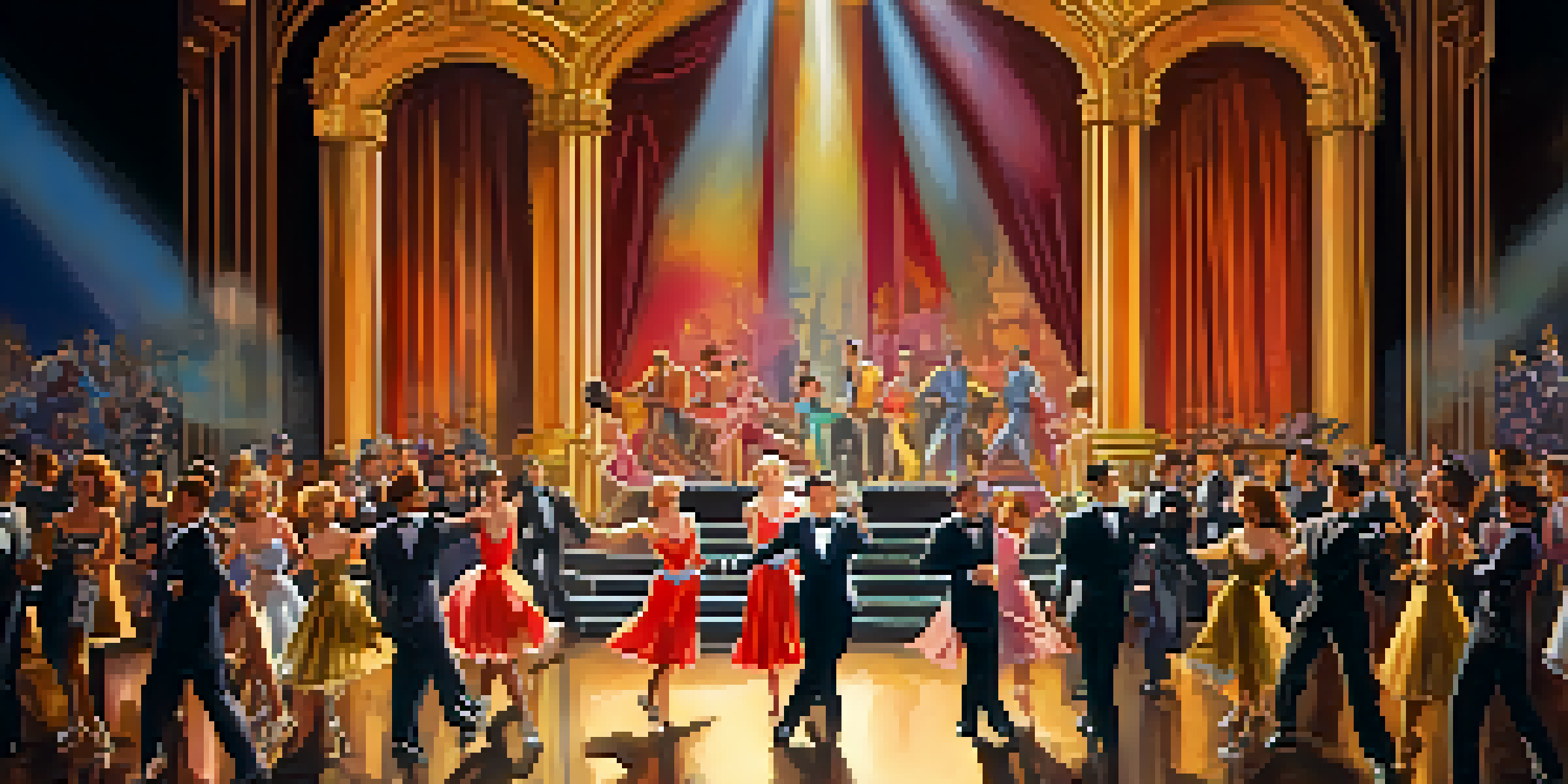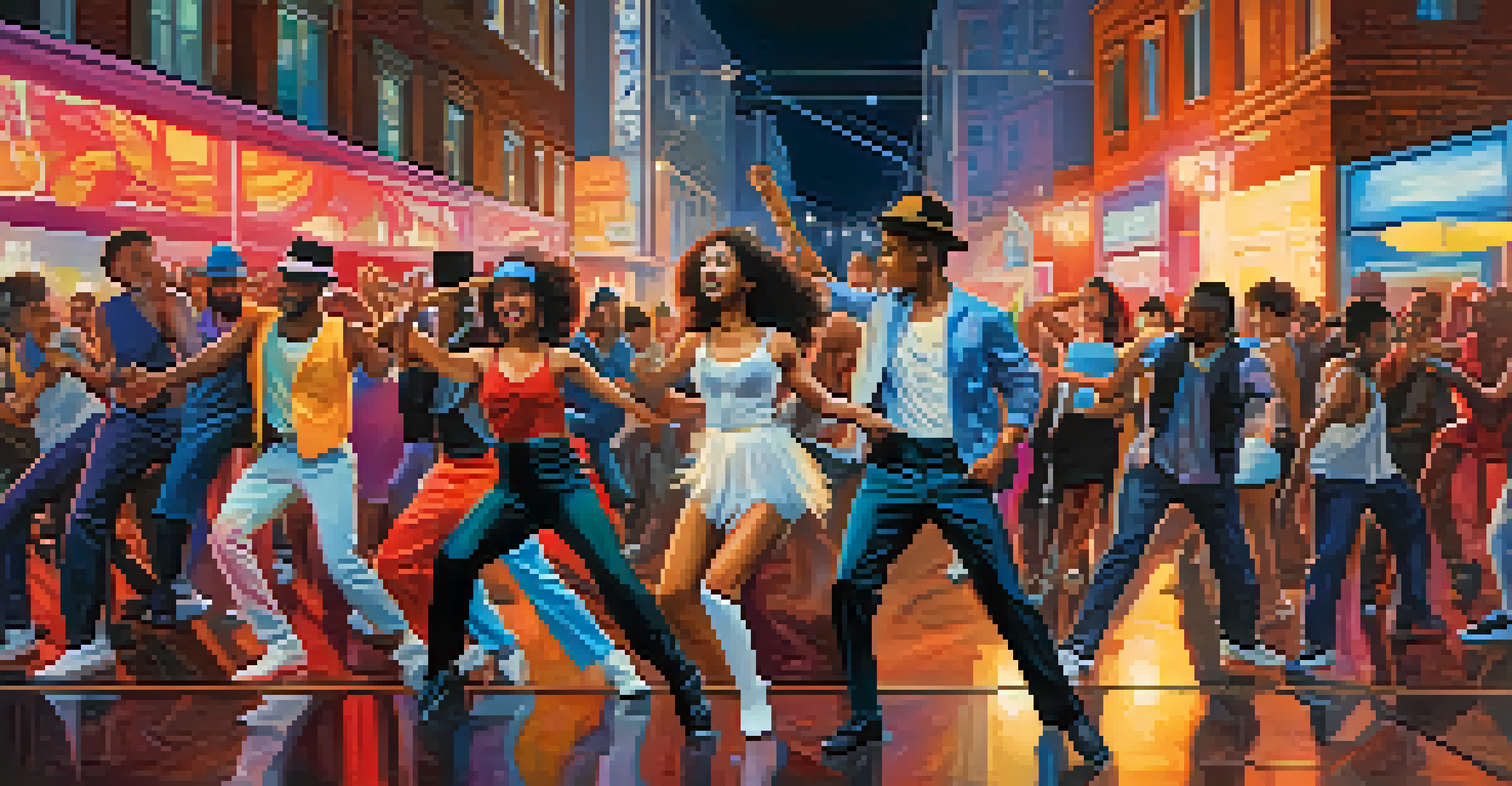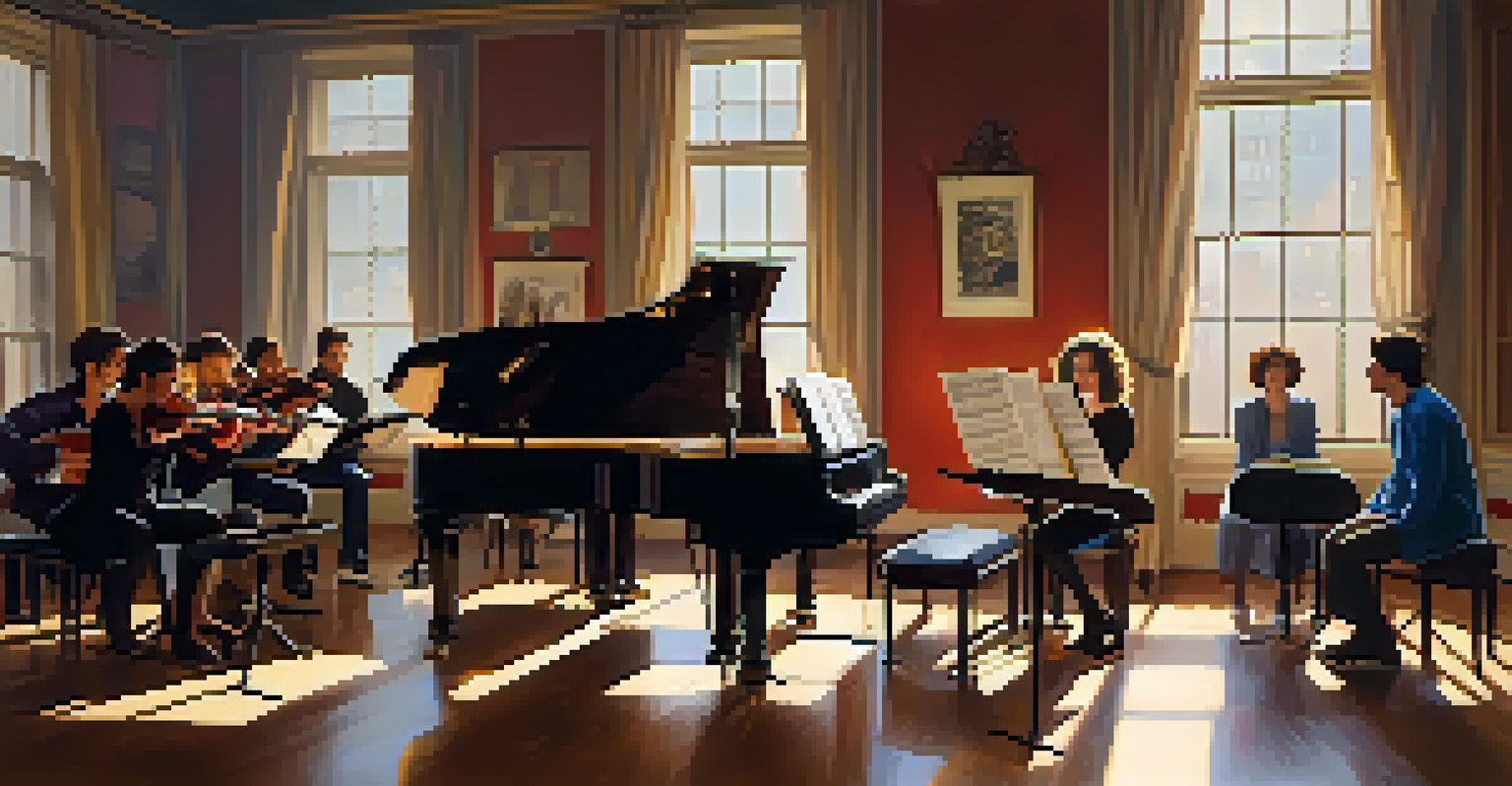Musicals Through Time: The Changing Beats of Film Song

The Birth of Musicals: A Historical Overview
Musicals have a rich history that dates back to the early 20th century, when silent films began incorporating live musical accompaniment. This evolution paved the way for the first sound films, where dialogue and music intertwined, creating a unique storytelling format. One of the earliest examples is 'The Jazz Singer' (1927), which marked a significant turning point in cinema. As audiences became enchanted with the blend of visuals and melodies, musicals began to flourish.
Musicals are the ultimate form of storytelling; they combine music, dance, and drama to create a unique art form that resonates with the audience.
During the Golden Age of Hollywood in the 1930s and 1940s, musicals exploded in popularity. Films like 'Singin’ in the Rain' and 'The Wizard of Oz' captivated viewers with their vibrant songs and choreography. These productions not only showcased star talent but also reflected the cultural zeitgeist of their time, often providing an escape during the Great Depression. Musicals became a staple, influencing the industry's direction and setting the stage for future innovations.
As we delve deeper into the evolution of musicals, it's essential to recognize how they adapted to societal changes. The themes and styles of musicals have shifted dramatically, reflecting the values and challenges of each era. From romantic ballads to upbeat dance numbers, the evolution of music in films mirrors the changing landscape of society itself.
The Golden Age: Iconic Films and Their Soundtracks
The Golden Age of Hollywood was characterized by musicals that became cultural phenomena, with unforgettable soundtracks that still resonate today. Films like 'West Side Story' and 'My Fair Lady' brought Broadway flair to the silver screen, combining powerful narratives with memorable songs. These musicals not only entertained but also tackled complex themes such as love, class struggle, and identity, making them timeless classics.

Audiences were enthralled by the lavish productions and stunning performances, which led to a surge in musical films throughout the 1950s and 1960s. The integration of song and dance created a unique experience that set these films apart from traditional dramas. Iconic numbers like 'I Feel Pretty' and 'Get Me to the Church on Time' remain ingrained in popular culture, illustrating the lasting impact of these films.
Musicals Evolve with Society
Throughout their history, musicals have adapted to reflect societal changes and cultural values, continually resonating with audiences.
Moreover, the music itself became a marketing tool, with hit songs often propelling musicals to success. The collaboration between talented composers and lyricists, such as Leonard Bernstein and Stephen Sondheim, resulted in groundbreaking scores that elevated the genre. The Golden Age laid the foundation for future musicals, influencing generations of filmmakers and musicians.
The Shift to Contemporary Musicals: A New Era
As the late 20th century approached, the landscape of musicals began to transform once again. The emergence of contemporary musicals in the 1980s and 1990s introduced a new style that incorporated diverse influences, ranging from rock to hip-hop. Productions like 'Rent' and 'The Lion King' showcased innovative storytelling techniques, appealing to younger audiences and revitalizing the genre.
The theater is a place where we can feel the pulse of our society, and musicals have an incredible ability to reflect the zeitgeist of our times.
The fusion of various musical styles opened doors for more experimental and eclectic productions. With the rise of pop culture, artists like Elton John and Lin-Manuel Miranda brought fresh perspectives to musical storytelling. The success of 'Hamilton' in particular marked a groundbreaking moment, blending history with modern beats and lyrics that resonated with a diverse audience.
Contemporary musicals also began to address more pressing social issues, reflecting the realities of modern life. Themes such as identity, race, and mental health became central to narratives, demonstrating the genre's ability to adapt and remain relevant. This evolution highlights the power of musicals to not only entertain but also provoke thought and inspire change.
The Role of Technology in Modern Musicals
Technology has played a pivotal role in the evolution of musicals, particularly in film. The integration of CGI and advanced sound design has transformed how stories are told, allowing for visually stunning and immersive experiences. Films like 'La La Land' and 'The Greatest Showman' utilized technology to enhance musical numbers, creating breathtaking sequences that captivated audiences.
Moreover, the rise of streaming platforms has altered how musicals are consumed. With platforms like Netflix and Disney+, musicals are now accessible to a global audience, broadening their reach and impact. This shift has led to a resurgence of interest in the genre, with new productions being developed to meet the demands of viewers.
Technology Transforms Musical Storytelling
Advancements in technology, from CGI to streaming platforms, have revolutionized how musicals are produced and consumed, enhancing their accessibility and appeal.
The influence of social media cannot be overstated, either. Platforms like TikTok have allowed songs from musicals to go viral, introducing new audiences to the genre. This accessibility has fostered a sense of community among fans and has even inspired live performances and adaptations, showcasing the enduring popularity of musicals in the digital age.
Cultural Impact: Musicals Reflecting Society
Musicals have always been a mirror reflecting the society in which they are created. From the exuberance of the 1920s to the struggles of marginalized communities in contemporary productions, musicals capture the zeitgeist of their times. They often serve as a commentary on social issues, making them relevant and relatable to audiences.
For instance, 'West Side Story' tackled themes of social injustice and racial tension, while 'Dear Evan Hansen' addressed mental health and the pressures of modern youth. These narratives resonate with viewers, sparking conversations and encouraging empathy. By exploring complex themes through music and performance, musicals can challenge perceptions and foster understanding.
Additionally, musicals offer a platform for underrepresented voices. The growing diversity in casting and storytelling allows for a richer tapestry of experiences to be shared. This evolution not only enriches the genre but also reflects a broader societal shift towards inclusivity and representation.
The Future of Musicals in Film: What Lies Ahead?
As we look to the future of musicals in film, it's clear that the genre will continue to evolve and adapt. With the integration of new technologies and innovative storytelling techniques, we can expect to see fresh perspectives and diverse narratives. The emergence of virtual reality and augmented reality could provide unprecedented opportunities for audience engagement, creating immersive experiences that redefine what a musical can be.
Moreover, the global influence of musicals is expanding. International productions are gaining popularity, with films like 'Mamma Mia!' and 'The Umbrellas of Cherbourg' showcasing the universal appeal of music and storytelling. This globalization presents exciting possibilities for cross-cultural collaborations and a more diverse representation in the genre.
Musicals as Cultural Commentary
Musicals serve as a mirror to society, addressing complex themes and fostering empathy, which makes them relevant and impactful across generations.
Ultimately, the future of musicals will hinge on their ability to resonate with audiences on a personal level. By continuing to explore themes that matter and embracing innovation, musicals can maintain their relevance and continue to touch hearts for generations to come.
Conclusion: The Timeless Allure of Musicals
In conclusion, the journey of musicals through time highlights their enduring appeal and transformative power. From their origins in early cinema to the contemporary masterpieces we see today, musicals have continuously evolved, mirroring societal changes and embracing new styles. The magic of film songs lies in their ability to connect with audiences, evoking emotions and telling stories that transcend time.
As we reflect on the past and look forward to the future, it's important to recognize the cultural significance of musicals. They not only entertain but also challenge us to think critically about the world around us. This unique blend of art and activism ensures that musicals will remain a vital part of our cultural landscape.

Whether you're a lifelong fan or new to the genre, there's no denying the power of a great musical. As we celebrate the changing beats of film songs, we invite you to continue exploring the rich tapestry of stories, melodies, and emotions that make musicals such a beloved and timeless art form.